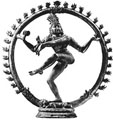| A Spatial View of Movement Discourse: Commentary |
The diagram shows a spatial representation of the relationship between enclaves, movements, and a dominant public. The "space" it shows is virtual, and the term "space" or "sphere" is a metaphor. Habermas defines the public sphere as "a realm of our social life in which something approaching public opinion can be formed", in which "access is guaranteed to all citizens." He then points out that "a portion of the public sphere comes into being in every conversation in which private individuals assemble to form a public body" ("PS" 49). This last sentence discloses the virtual nature of a sphere of discourse.
What is a dominant public?
A fully rhetorical theory of the public
sees the public and public space as recursive constructions, created
by the same discourse they
host (Giddens). In other words, the public sphere itself is composed
of ideas about the boundaries, agents, rules, and topoi of public discourse.
Who is a citizen? Who has the right to speak? How, when, where, why
and on what subjects should citizens engage in public debate? All these
boundary conditions are expressed and altered (produced and reproduced;
Giddens) in the practice of public discourse itself. In a sense they
are part of the constitutive voice of a movement or public (Charland;
Burke; Lake; see below).
Movements challenge these unstated assumptions that construct the "publicness" of public discourse. They reveal that such assumptions are neither static nor given. Instead they show the discursive construction of discourse in the act of being produced and reproduced in every exchange (Bakhtin).
What do "constitutive" and "oppositional"
refer to?
When a movement agitates for change within
the dominant public, the shape of both publics will change in the resulting
interaction, as boundaries are shifted, agents are re-characterized
(Burke), rules are tested, and argument topoi are borrowed or coined.
In the diagram, all publics have in potential an oppositional and a
consitutive rhetoric. The constitutive voice is inner-directed. It
acts to thematically reinforce group identity. The oppositional voice
is
other-directed.
It challenges
the larger public, yet in doing so also defines a movement or public
over against a
vilified
"other."
When is a movement a movement
and not an enclave?
Many if not most enclaved publics are
not movements. Whether large or small, many enclaves distance themselves
from the dominant public in order to accomplish a purpose. Some are more
permeable than others (Bakhtin, Douglas). Radical religious sects that
do not proselytize, like the Amish or Quakers; hobbiests; literati;
foodies; many of these groups include individuals who simultaneously
operate freely as members of the dominant public. Not every distinct
demographic becomes a discursive enclave. Children; mentally ill or incapacitated;
criminals; women; racial minorities, do not become enclaves until such
time as they become rhetorically aware of their existence as a group.
 |
| Examples |